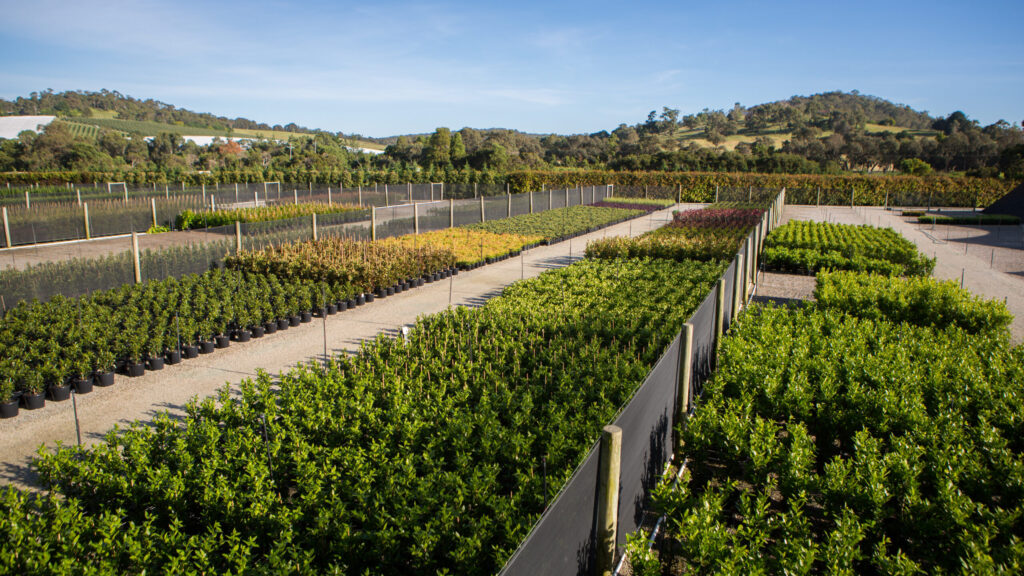Do you have a green thumb?
Maybe you’re fascinated by plants or thrive when you’re creating and innovating. From sprouting seeds and designing green spaces to working with emerging technologies, there’s a career in horticulture for everyone.
Explore your options in this thriving industry
Production Nurseries
Retail Nurseries
Turf Industries
Manufacturing
Infrastructure and Technology
Production Nurseries
This is where green life begins.
There are different types of production nurseries, that might grow seedlings, vegetables, flowers, advanced trees, or anything in between.
Depending on the nursery, plants are grown for varying periods of time before being sold on to retail nurseries, landscapers, communities, urban greeners or revegetation projects.
Working in a production nursery could see you sourcing seeds, cuttings or tissue culture, or even new genetic material from overseas.
You might be involved in propagating, grafting, pruning, identifying diseases and ensuring that plants remain healthy.
Retail Nurseries
Retail nurseries are where people seek inspiration, advice, and plants to bring their spaces to life.
Being on the front line of customer service, you’ll help to educate home gardeners and fuel their passion for plants.
As a part of a retail nursery team, you’ll not only assist customers in selecting the perfect plants for their needs but also contribute to creating an immersive and educational environment that fosters a deeper connection between individuals and the world of gardening.
Your expertise will play a pivotal role in nurturing thriving gardens and turning gardeners’ dreams into vibrant realities.
Turf Industries
A career in the turf industry could involve the breeding, growing, maintaining, marketing and sales of turf for our homes, public parks or our major sporting fields and golf courses.
You could be specifying turf for projects, amending soil quality, managing irrigation, troubleshooting turf health issues, all to ensure an optimal turf harvest.
Venturing into sports turf management, could offer opportunities to manage turf maintenance at prestigious sports stadiums, and providing world class playing surfaces for our local and international stars in a variety of sports.
Manufacturing
Businesses involved in the manufacturing aspect of horticulture include those producing the growing media that nurseries, landscapers and the home gardener will use to produce healthy plants and landscapes.
They may develop and create the growing containers that plants are potted into, such as pots, bags or trays. Or they may create the labels and promotional material that people use to identify, sort and sell plants.
In a manufacturing role, you’ll produce the things that a home gardener or horticultural enterprise needs to grow their plants or their business.
Infrastructure and Technology
A career in infrastructure and technology in the horticulture industry puts you at the forefront of new technologies that improve plant growth, maintenance and health.
Your role could include anything from installing large-scale nursery infrastructure, to developing LED lights that encourage optimal plant growth.
Staying up to date with cutting-edge innovations in automation, data analysis, and sustainable practices will be essential as you contribute to revolutionising the horticulture industry and addressing global food security and environmental challenges.
Crop Protection and Nutrition
Controlling pathogens or pests traditionally involves targeted use of agrochemicals like pesticides, but more environmentally friendly methods are now being adopted.
People in this area of horticulture conduct research and development to find creative solutions, manufacture and formulate their products, and distribute them to horticulturalists and other agricultural industries.
They may also provide technical support, training, and consulting services to help horticulturalists improve management practices and become more sustainable.
Landscaping and Design
The landscaping industry undertakes activities related to outdoor space design, creation, maintenance, and improvement.
This may include landscape design, planting, hardscaping, irrigation and drainage, lawn care, landscape construction, landscape lighting, and landscape maintenance.
The landscaping industry is a hands-on way to create and maintain green spaces.
Landscaping and design roles predominantly work directly with clients, to bring functional, sustainable and beautiful spaces to life.
Conservation Management
Conservation management brings cleared land or damaged waterways back to life by replanting native vegetation.
This plays a crucial role in restoring and conserving natural ecosystems and protecting biodiversity, and activities typically include site preparation, seed collection, plant propagation, and planting to restore and enhance the natural environment.
By reintroducing native plant species and restoring the delicate balance of local flora and fauna, conservation management not only improves habitat quality but also helps mitigate erosion, filter pollutants, and support the resilience of ecosystems against future environmental challenges.
Parks and Gardens
You’ll be responsible for the care and management of community green spaces, whether it’s a rose garden, a sporting oval or a public park.
This might include designing the landscape, planting, constructing natural playing surfaces and managing irrigation.
Other responsibilities might include pruning, mulching, and watering; lawn care, weed and pest control; and general maintenance.
They ensure that public parks and gardens are clean, safe, and visually appealing for the community to enjoy.
Arboriculture
Arborists are often referred to as tree doctors, tree surgeons or climbers. They are professionals who specialise in the care and maintenance of trees.
You could find yourself climbing trees using saws, clippers and shears, examining them for any damage from storms, decay, poor nutrition or diseases, and pruning them to enhance their form.
Additionally, arborists may also provide guidance on planting new trees, diagnosing pest infestations, and implementing strategies to ensure the overall health and longevity of trees within various landscapes.
Crop Protection and Nutrition
Landscaping and Design
Conservation Management
Parks and Gardens
Arboriculture
Production Nurseries
Retail Nurseries
Production Nurseries
This is where green life begins.
There are different types of production nurseries, that might grow seedlings, vegetables, flowers, advanced trees, or anything in between.
Depending on the nursery, plants are grown for varying periods of time before being sold on to retail nurseries, landscapers, communities, urban greeners or revegetation projects.
Working in a production nursery could see you sourcing seeds, cuttings or tissue culture, or even new genetic material from overseas.
You might be involved in propagating, grafting, pruning, identifying diseases and ensuring that plants remain healthy.
Retail Nurseries
Retail nurseries are where people seek inspiration, advice, and plants to bring their spaces to life.
Being on the front line of customer service, you’ll help to educate home gardeners and fuel their passion for plants.
As a part of a retail nursery team, you’ll not only assist customers in selecting the perfect plants for their needs but also contribute to creating an immersive and educational environment that fosters a deeper connection between individuals and the world of gardening.
Your expertise will play a pivotal role in nurturing thriving gardens and turning gardeners’ dreams into vibrant realities.
Turf Industries
Manufacturing
Turf Industries
A career in the turf industry could involve the breeding, growing, maintaining, marketing and sales of turf for our homes, public parks or our major sporting fields and golf courses.
You could be specifying turf for projects, amending soil quality, managing irrigation, troubleshooting turf health issues, all to ensure an optimal turf harvest.
Venturing into sports turf management, could offer opportunities to manage turf maintenance at prestigious sports stadiums, and providing world class playing surfaces for our local and international stars in a variety of sports.
Manufacturing
Businesses involved in the manufacturing aspect of horticulture include those producing the growing media that nurseries, landscapers and the home gardener will use to produce healthy plants and landscapes.
They may develop and create the growing containers that plants are potted into, such as pots, bags or trays. Or they may create the labels and promotional material that people use to identify, sort and sell plants.
In a manufacturing role, you’ll produce the things that a home gardener or horticultural enterprise needs to grow their plants or their business.
Infrastructure and Technology
Crop Protection and Nutrition
Infrastructure and Technology
A career in infrastructure and technology in the horticulture industry puts you at the forefront of new technologies that improve plant growth, maintenance and health.
Your role could include anything from installing large-scale nursery infrastructure, to developing LED lights that encourage optimal plant growth.
Staying up to date with cutting-edge innovations in automation, data analysis, and sustainable practices will be essential as you contribute to revolutionising the horticulture industry and addressing global food security and environmental challenges.
Crop Protection and Nutrition
Controlling pathogens or pests traditionally involves targeted use of agrochemicals like pesticides, but more environmentally friendly methods are now being adopted.
People in this area of horticulture conduct research and development to find creative solutions, manufacture and formulate their products, and distribute them to horticulturalists and other agricultural industries.
They may also provide technical support, training, and consulting services to help horticulturalists improve management practices and become more sustainable.
Landscaping and Design
Conservation Management
Landscaping and Design
The landscaping industry undertakes activities related to outdoor space design, creation, maintenance, and improvement.
This may include landscape design, planting, hardscaping, irrigation and drainage, lawn care, landscape construction, landscape lighting, and landscape maintenance.
The landscaping industry is a hands-on way to create and maintain green spaces.
Landscaping and design roles predominantly work directly with clients, to bring functional, sustainable and beautiful spaces to life.
Conservation Management
Conservation management brings cleared land or damaged waterways back to life by replanting native vegetation.
This plays a crucial role in restoring and conserving natural ecosystems and protecting biodiversity, and activities typically include site preparation, seed collection, plant propagation, and planting to restore and enhance the natural environment.
By reintroducing native plant species and restoring the delicate balance of local flora and fauna, conservation management not only improves habitat quality but also helps mitigate erosion, filter pollutants, and support the resilience of ecosystems against future environmental challenges.
Parks and Gardens
Arboriculture
Parks and Gardens
You’ll be responsible for the care and management of community green spaces, whether it’s a rose garden, a sporting oval or a public park.
This might include designing the landscape, planting, constructing natural playing surfaces and managing irrigation.
Other responsibilities might include pruning, mulching, and watering; lawn care, weed and pest control; and general maintenance.
They ensure that public parks and gardens are clean, safe, and visually appealing for the community to enjoy.
Arboriculture
Arborists are often referred to as tree doctors, tree surgeons or climbers. They are professionals who specialise in the care and maintenance of trees.
You could find yourself climbing trees using saws, clippers and shears, examining them for any damage from storms, decay, poor nutrition or diseases, and pruning them to enhance their form.
Additionally, arborists may also provide guidance on planting new trees, diagnosing pest infestations, and implementing strategies to ensure the overall health and longevity of trees within various landscapes.







































